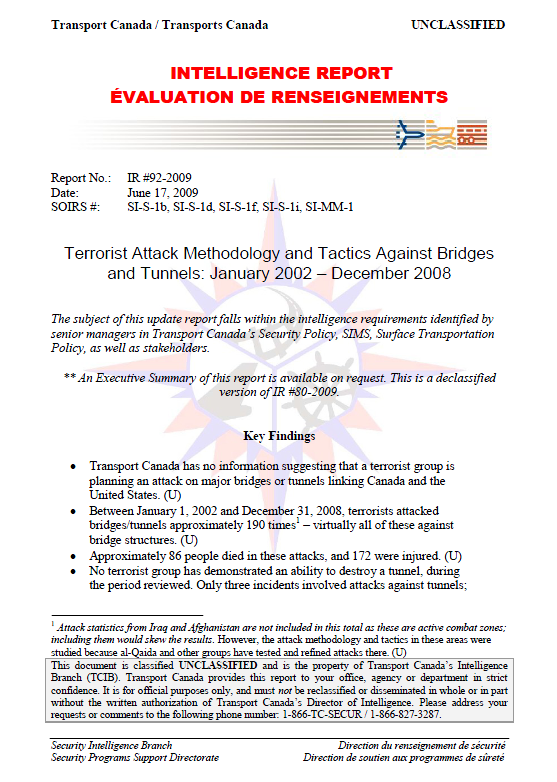 Transport Canada Security Intelligence Branch
Transport Canada Security Intelligence Branch
- 12 pages
- Unclassified
- June 17, 2009
Key Findings
- Transport Canada has no information suggesting that a terrorist group is planning an attack on major bridges or tunnels linking Canada and the United States. (U)
- Between January 1, 2002 and December 31, 2008, terrorists attacked bridges/tunnels approximately 190 times1 – virtually all of these against bridge structures. (U)
- Approximately 86 people died in these attacks, and 172 were injured. (U)
- No terrorist group has demonstrated an ability to destroy a tunnel, during the period reviewed. Only three incidents involved attacks against tunnels; one in Pakistan in January 2008, one in December 2006 in India, and one in Colombia in April 2006. None resulted in serious damage. (U)
- The five countries attacked most frequently (Colombia, Pakistan, India, Nepal and Thailand) accounted for 77 percent of all attacks – 147 incidents. (U)
- Most bridge attacks involved terrorists placing an improvised explosive device on a bridge and detonating it, causing little permanent damage. (U)
- Terrorists attack bridges for a variety of reasons: destroy or damage the structure, restrict movement, attack troops or some other human target (e.g. a city mayor). (U)
- Only once in the past seven years have terrorists planted a second IED at a bridge aimed at killing or wounding first responders and rail workers. (U)
- Since 2007, al-Qaida and/or sympathetic groups have conducted a campaign targeting bridges in Iraq and Afghanistan, and have developed effective methodology and training to carry out an attack. However, few other terrorist groups have demonstrated a capability to destroy large bridges; “softer” (human) targets are more vulnerable to attack. (U)
- Major bridges spanning the U.S.-Canada border have been subjected to many suspicious incidents, including videotaping, bomb threats and underwater inspections. No information suggests that these suspicious incidents were carried out by terrorist groups. (U)
- Many Canadian bridges have been subjected to direct and indirect pressure tactics by domestic or single/multi-issue groups – none of which have seriously threatened the structure. (U)
Introduction
Canada has many large bridges and tunnels, including 24 international vehicular bridges and tunnels linking Canada and the United States – specifically to the states of Maine, Vermont, New York, Michigan and Minnesota. Fourteen of these bridges and tunnels are in Ontario, nine are in New Brunswick, and one is in Quebec. As well, there are nine international railway bridges and tunnels – eight in Ontario, with another one in New Brunswick. Damage to one or more of these structures would cause short to medium-term traffic congestion at the border, and would hurt the economy of both countries.
…
Since 9/11, al-Qaida and other Sunni extremists have indicated an interest in attacking bridges – although most of their attacks have occurred in combat areas and had clear military objectives. Not only has al-Qaida actually trained adherents on how to attack bridges, but the organization has even produced videos and printed resources (complete with illustrations) showing precisely where to plant explosives, and pointing out structural weaknesses and stress points in various bridge structures. San Francisco’s Golden Gate Bridge was featured in one of these al-Qaida videotapes. (The Encyclopedia of Afghan Resistance has also published this data as it relates to suspension bridges. See illustration.) In 2003, al-Qaida reportedly considered an attack on New York’s Brooklyn Bridge.5 Threats have also been made against Baltimore’s harbour tunnel, and in 2006 terror plots were discovered against the Holland Tunnel (linking New York to New Jersey) as well as the Chunnel (linking England to France). (U)
Most bridge attacks today generally result in little permanent damage to the structure. Primarily this is because terrorists use small IEDs that don’t have enough explosive force to destroy or significantly harm a large steel and concrete structure. In many cases, bridges are operating again shortly after a bomb explosion. When terrorists devote more time to the planning process and identify the most critical, high stress points on a bridge (e.g. important support pylons or suspension cables), their chances of destroying it increase
dramatically.…
APPENDIX A
Bridges Attacked by Terrorists
Colombia 43
Pakistan 35
India 32
Nepal 27
Thailand 10
Georgia 6
Kenya 5
Turkey 4
Laos 4
Russia 4
Burma/Myanmar 4
Algeria 2
Sri Lanka 2
South Africa 2
Philippines 1
Ecuador 1
Indonesia 1
Angola 1
Ethiopia 1
Serbia/Montenegro 1
Egypt 1
Greece 1
Kosovo 1
United States 1
